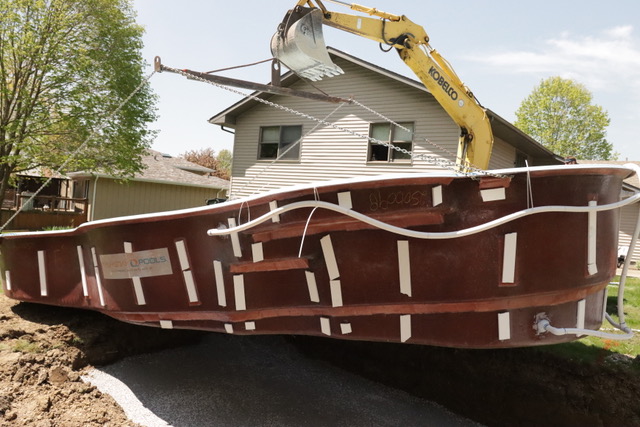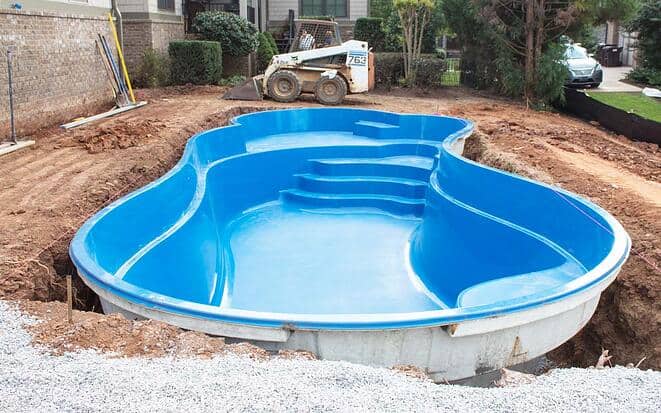What Is A Fiberglass Pool Shell?

If you’re thinking about purchasing an inground pool, you may be facing a dilemma of oceanic proportions. “Which type of pool should I get? Concrete, vinyl liner, or fiberglass?” If you’re considering fiberglass, you have come to the right place. Fiberglass pools are rising in popularity because of their durability and quick installation times. At the heart of every fiberglass pool is a crucial component—the fiberglass pool shell.
If you’re considering a fiberglass pool, then you probably want a quicker installation process and less maintenance to do. What are some other concerns? If you have ever heard the term “fiberglass pool shell” or “fiberglass pool mold” you may be wondering what exactly that means. “I thought all inground pools were built and installed directly in the ground??”
You’d be forgiven for making this assumption. Of the three inground pool types (concrete/gunite, vinyl liner, and fiberglass), fiberglass pools are the only pool type that is not built entirely on the construction site.
So what is the fiberglass pool shell? Where is it built? How is it built? Let’s get into it!
How Fiberglass Pool Shells Are Made
The fiberglass pool shell is a one-piece structure, custom-molded in a controlled factory environment. It starts with a precise mold that defines the shape and design of the pool—steps, benches, curves, and depths included.
Fiberglass starts as fine, hair-like strands produced by melting glass and pushing it through tiny holes. These fibers are then woven into larger sheets and combined with resins, creating a composite that is both lightweight and highly durable.
When you decide which pool design you want, the manufacturer will use a pool mold of the design to spray the fiberglass around, creating what will become the pool shell.
This specialized manufacturing process makes fiberglass pools resistant to cracking, fading, and algae buildup. This reduces the amount of time and money you spend on maintenance over time. It usually takes about 1-2 days to build the pool shell around the mold. But there is actually another step builders must take before creating the mold. That would be the plug or pool design pattern.
How Are Fiberglass Pools Made?
Creating the Pattern or “Plug”
The plug is a full-size, three-dimensional model of the desired pool shape. The plug is a replica of a pool design used to form the mold. The plug is comprised of wood, fiberglass, or other shaping materials, then smoothed and coated to reflect the final look of the pool, including steps, ledges, benches, and curves.
This phase is all about precision. Every inch of the plug must match the pool shell design, as any imperfection will be carried through to every pool made from it.
Creating the Mold
Once the plug is perfected, builders move on to creating the mold, which will serve as the base upon which all fiberglass pools of that specific design are built. The mold is comprised of fiberglass and a steel frame.
After curing, this mold is carefully separated from the plug and becomes the reusable form used to manufacture actual fiberglass pool shells.
The mold is then polished and coated with a gel coat—this is the same material that will give each pool its smooth, glossy finish. Proper maintenance of the mold is crucial; a high-quality mold ensures consistent pool shell production with a flawless surface.
Creating the Pool Shell

Now comes the actual creation of the fiberglass pool shell. The process starts with technicians adding layers of fiberglass and resin to build the structural body of the pool on top of the mold. Some manufacturers use vinyl ester resin in the first few layers to enhance resistance to water penetration and osmotic blistering. Vinyl ester resin is the strongest resin available for fiberglass construction.
Once all the fiberglass layers are applied and fully cured, the solid pool shell is removed from the mold, cleaned, and inspected for quality. At this stage, the fiberglass pool is complete and ready to be shipped.
How They Are Brought Into Your Backyard
Unlike concrete pools that are constructed piece by piece on-site, fiberglass pools arrive ready to install. The pool construction process with a fiberglass shell is significantly faster—often taking just days instead of weeks.
After the pool shell has been cleared and inspected it is loaded onto a large freight vehicle. The truck then brings the pool to the installation site. This is why fiberglass pools generally cap out between 40-43 feet long, as a truck cannot support and transport too large of a fiberglass pool.
Fiberglass pool installers use the time that the pool is being built to dig out the hole your pool will sit in. Because of their unique construction process, your fiberglass pool will arrive at a pre-dug hole in your backyard. A base of gravel is prepared, and then the shell is craned or lifted into place.
Final Thoughts
A fiberglass pool shell offers an efficient, durable, and visually stunning option for anyone considering an inground pool. Though they are built differently than other pools, they offer unmatched durability and ease of maintenance. After all is said and done, a fiberglass pool will provide years of fun memories.
If you have more fiberglass pool questions, check out the articles below. For more educational content on all things pools and landscaping, head over to our learning hub.
Top 3 Most Popular Thursday Pools Fiberglass Designs of 2025
Thursday Pools vs. Leisure Pools: An Honest Comparison of Fiberglass Pool Manufacturers
written by Logan Edgemon
